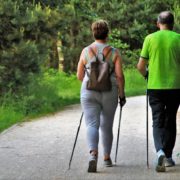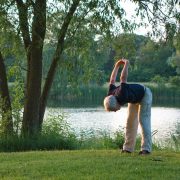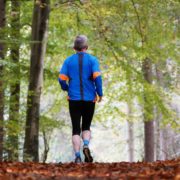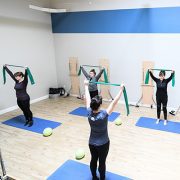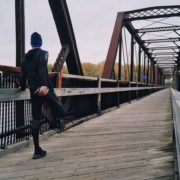Getting and Staying Fit when you’re Over 50
The importance of being healthy and fit has taken center stage these last 18 months, but especially for the over 50 crowd. Most people aged 50+ who want to get and stay fit struggle, because what might work for someone in their 20’s or 30’s just doesn’t make sense for them in their 50’s. As you age, both your needs AND your priorities change.
By the time you hit age 50, you may start to suffer from things like arthritis, degenerative and aging joints, and more back and knee pain. And if you aren’t suffering from them yet, you’re worried about when you will. First, let me just tell you that it is 100% possible to get and stay fit after 50. I have the joy of working with folks aged 50+ every day who are the healthiest they’ve ever been in their lives. So what’s their secret?
Here are 5 habits my healthiest clients aged 50+ stick to so they can get and stay fit:
1. Get enough sleep
The myth that you don’t need as much sleep as you get older is false. Most research indicates that even when you’re over 50, you should still be aiming for 7-9 hours of sleep per night. When you don’t get enough sleep, it catches up to you. You lack energy, making you less motivated to exercise and more likely to eat sugary, unhealthy foods. Lack of sleep lowers your immune system, affects your memory and ability to focus, impacts your balance, and increases your chances of developing high blood pressure. In general, lack of sleep is going to significantly impact your ability to eat well and exercise, two essential ingredients for getting and staying fit after age 50.
2. Keep Nutrition Simple
If you’re over age 50, you’ve likely seen every cleanse, crash diet, health shake, weight loss pill, or gimmick known to man. There literally isn’t a trick left in the book you haven’t seen. At age 50+ you also typically aren’t in the mood to be a nutritional extremist either. It’s a good idea to just keep things simple. Focus on eating nutritious whole foods (things that are unprocessed) and drink plenty of water. Start your day with an 8oz glass of water and then aim to drink at least 3 more bottles after that. When you’re planning meals, make your plate up with half vegetables, one quarter protein, and one quarter whole grains. Adding a little bit of healthy fat consisting of plant oils is a good idea too. Good nutritional habits give you the energy and stamina you need to get and stay fit!
3. Lift Weights
I can’t tell you how often I get asked “is it safe to be lifting heavy weights at my age?” People worry that lifting heavy weights could be “bad” for their spine or knees once they’re aged 50+. Lifting weights is not only good for you, but perfectly safe when done correctly. But it’s important that your workout is customized and takes into account any injuries or ailments you may have. Arthritis in your joints, bulging discs, and even meniscus tears are all normal things that occur as you age. They don’t mean you can’t exercise — but you do want to make sure your strength training routine reflects this.
As a physical therapist, the two biggest things I look at when I’m examining someone’s strength routine are form and loading strategies. Good and proper form is critical to protect your joints and back. “Loading” refers to how much weight you lift and how often (reps). This changes as you age because the integrity of your soft tissue (muscles and ligaments) is different. Loading strategies also need to be adapted if you’re injured or in pain. A good strength coach and physical therapist, especially when working together, can make sure that you have a strength training routine that is not only safe but perfect for your age and ability.
4. Strengthen your Core
After age 50 things like balance and reaction times start to become more compromised, and the likelihood of back pain increases. Maintaining good core strength helps with all of this and becomes more important than ever at age 50+. The biggest problem I see with people trying to strengthen their core is that they just don’t know how to do it properly. They may be doing all the right things, but with all the wrong muscles. If you’re new to core strengthening, or perhaps you’ve been doing it awhile but your core strength still isn’t where you want it to be, consider trying Pilates. It’s long been known as the staple of core strengthening because it requires you to perform very controlled and precise movements while focusing on your breath. Having proper control over your breath, body, and movement are the cardinal signs of a truly functioning and strong core.
5. Address Pain
This may seem obvious, but I can’t tell you how many people either ignore or just work around their pain. When you ignore your pain, you risk developing other problems due to your body compensating. These compensation strategies may last you for a short time, but eventually they will catch up to you. When you’re over 50, recovering from injury is harder and takes longer. So although preventing injury is your best strategy, don’t just ignore pain if you’re experiencing it. When you work around pain, it’s impossible to get the most you can out of your workouts and this delays your ability to get and stay fit. If you’re always having to modify exercise or compensate for pain, not only is this frustrating, but you delay getting to the root cause of your problem. Simply put, if you’re experiencing musculoskeletal pain — get it addressed.
We are a team of specialists who are specifically trained to help you address these issues. If you’re interested in an assessment, consultation, or simply want a couple questions answered — sign up for one of our FREE Discovery Sessions! This 30 minute session allows you to talk one-on-one with a movement expert to figure out what you want, need, and how you’re going to get there.

